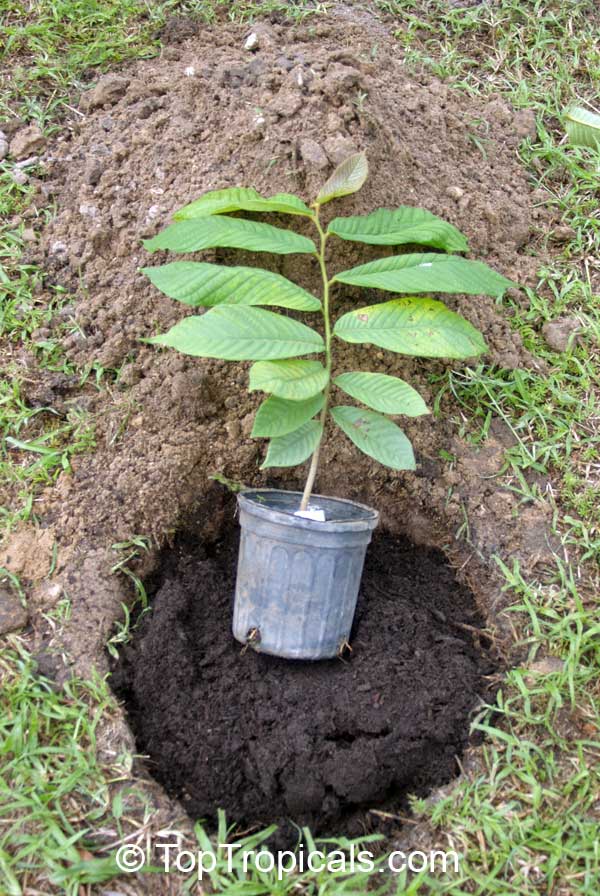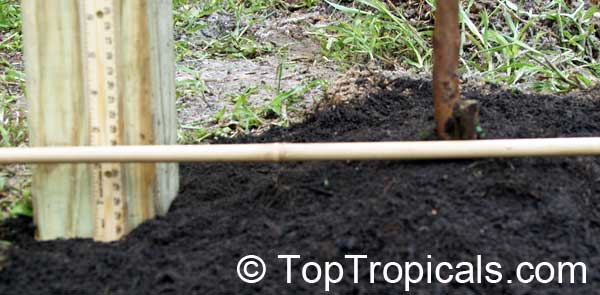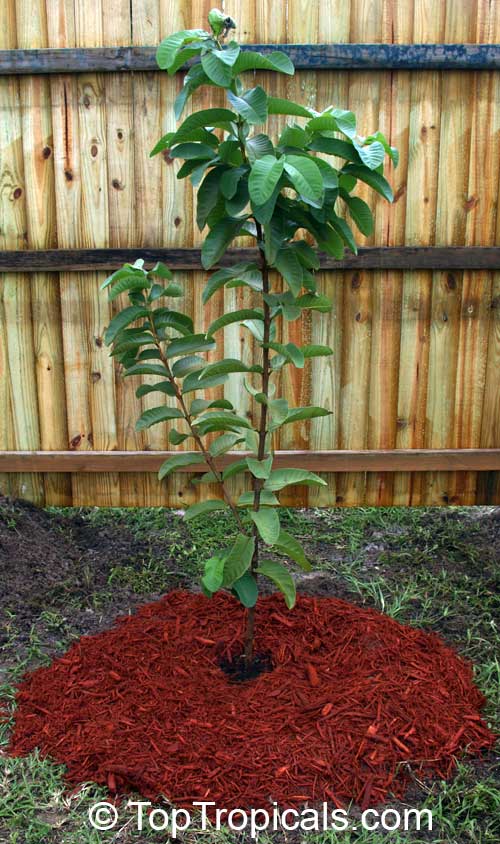TopTropicals guide to in-ground planting
How to plant a tree?
A wise man said, "One's life is worthwhile as long as one had completed the Tree Tasks: 1) build a home, 2) raise a child, and 3) plant a tree". For the most people, the first task as an American Dream sooner or later comes true; the second task is challanging but inescapable, but the third... what can be easier than planting a tree? When we think about it at TopTropicals, we realize that with the number of trees we have planted ourselves so far or provided to other people for planting, we have already fulfilled pretty significant part of any environmental "Save-a-Tree" project, which pretty much cancels a question about how big of a house we built or how good parents we are... However, believe it or not, it took us quite a few trees to kill to finally figure out how to do it right!
Is it easy to plant a tree?
It's as easy as 1-2-3.
1. Start for all - make a hole
Dig a hole at least 2-3 times bigger than the pot size. Actually, the bigger the better, as long as you fill it with a good quality media. We use organic composted manure for planting fruit trees, gardenias - most of the plants that require rich organic soil. Depending on the original soil you have in your yard, you can mix compost with existing soil from the hole, as long as it doesn't contain limestone or shells. If you have almost pure sand like we do (or clay, etc.), in this case it has to be all replaced with better soil.
Fill the hole with the planting mix almost all the way to the top, leaving the space on top a little shorter than the hight of the pot.
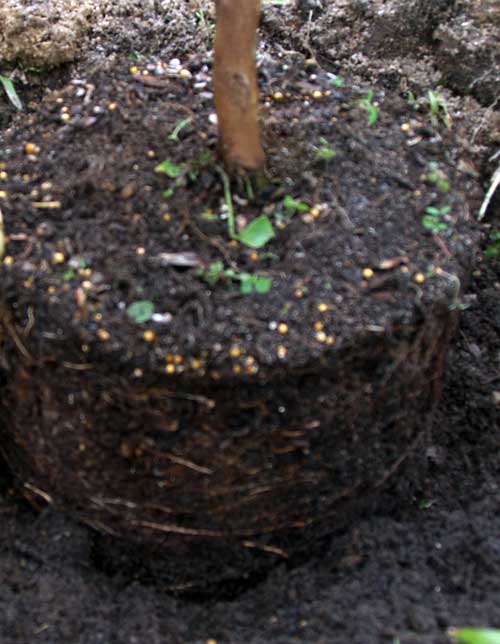
2. Level makes the difference
Carefully remove plant out of the pot, place the root ball on top of the planting mix, and add more soil around it. Now here comes the most important point in your planting project: the position of the root ball.
a) Make sure the growing point (the point where the stem/trunk turns into a root system) stays the same level, and no extra soil put on top of it, so the base of the trunk stays open as it was when the plant was in a pot. This is of a vital importance. If the root base is suffocated with extra soil or mulch, most likely it will cause rot/mold around it, and the plant has big chances to die. When we plant a tree, sometimes we leave little weeds around the trunk base: if left exposed, along with particles of perlite and granulated fertiliser from the original potting mix, they provide visual control for the growing point level above the surrounding surface (see picture on the left). When the planting is completed and proof-checked, those weeds can be cleaned out.

b) When filling the space around the root ball with a planting mix, make sure to create a little "mount" instead of planting on the same level with the ground around. Add extra planting mix as needed underneath the root ball. Elevated position of the growing point is especially important for areas with rainy seasons, when parts of the garden can be flooded, even temporarily. 1-2-3 inch elevation is enough, depending on specific flooding conditions. As long as the base of the trunk is above the surrounding surface, the tree will have greater chances to survive flooding. Also keep in mind that the new porous mix will compress with time after waterings, it may "sink" the tree down for another 1/2-1 inch. Very often even properly planted trees end up being planed too low just because of the potting mix got compacted underneath it.
However, remember that planting too high is not good either, and may cause drying out while the root system is not well-established and the plant has no deep access to water. Some trees can be very sensitive to drying out, like Guava, Litchi, Ylang-Ylang, Erblichia. Although they require a perfect drainage and somewhat tolerant to dry conditions, they still need lots of water to establish.
Picture (will be added at TT): commercial plantings of Mango and Litchi. Note how high the trees are planed using raised beds.
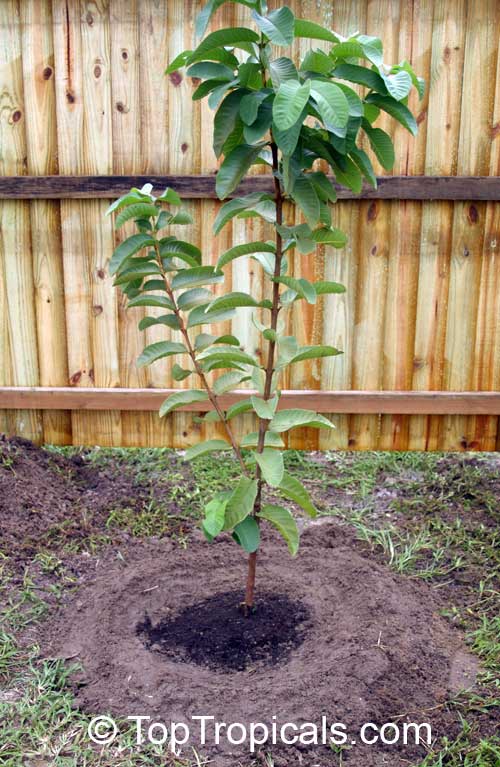
3. Make it cute
What to do with the extra dirt taken out of the hole? Use it to complete a "cone" around the tree. Put the old soil around the new planting as a "bagle", ot "ring" - this will create additional barrier for the irrigation water to retain during establishing period.
Put mulch around the planting. It will fill all imperfections of the mount you created.
IMPORTANT: leave open space 1-2" arounbd the trunk, so the mulch won't touch the stem. It will provide necessary air circulation and avoid possible mold/rot problems to the bark.
Now it is time to water, soak it.
(Don't try to water without mulch around, it won't work, the water will just run away.)
Note the open space around the trunk left without mulch
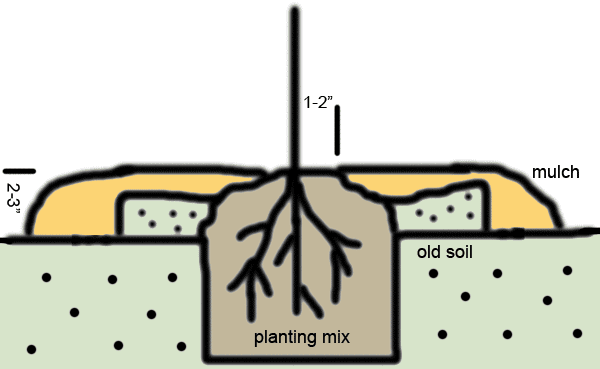
DIY low budget tip:
Poor Man Mulch
If your neighbor after mowing a lawn rakes all the cut grass into bags for future disposal, you may ask him to give it away to you rather than a trash can. Cut grass (hay) is a good source of Nitrogen (which is already good for neighbors' green grass, but either he doesn't want to know about it, or he is not a poor man indeed and prefers costy fertilizers for his manicured lawn). Besides, it works as the best natural mulch. After a few rains, the compressed hay will block weeds pretty good. And of course, you can always put some fancy mulch on top of it.
Now that you completed this class how to plant a tree, you can try it yourself. If it works out - 1/3 of your Life Meaning is successfully fulfilled!
